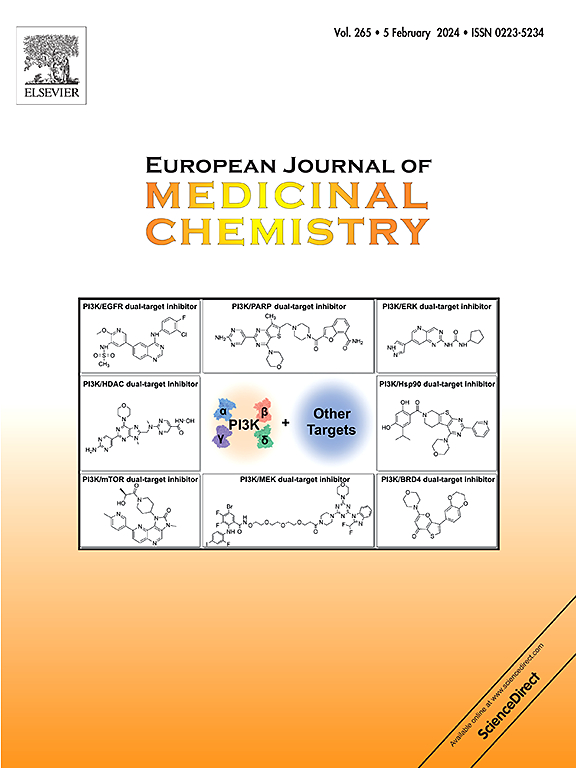螺-杂环取代二氨基萘Keap1-Nrf2蛋白-蛋白相互作用抑制剂的设计
IF 5.9
2区 医学
Q1 CHEMISTRY, MEDICINAL
引用次数: 0
摘要
氧化应激、炎症和Keap1-Nrf2通路被证实与抑郁症有关。理论上,调节Keap1和Nrf2蛋白-蛋白相互作用(PPI)应该是激活Nrf2治疗重度抑郁症的有效方法。我们之前报道了NXPZ-2,一种1,4-二氨基萘,作为Keap1-Nrf2 PPI抑制剂,在阿尔茨海默病(AD)小鼠模型中显示出有希望的效果。然而,其药代动力学性质有限。本文首次采用“逃离平面”策略,开发了一系列杂环取代二氨基萘,以改善sp3杂化碳。这些化合物对Keap1具有较强的结合亲和力。晶体学分析显示CD-10与Keap1蛋白的高分辨率(1.44 Å)结合,阐明了CD-10结合机制的复杂性。在lps刺激的BV2细胞模型中,CD-10表现出最佳的抗氧化应激和抗炎潜力。此外,CD-10穿透血脑屏障的能力也得到了显著提高。在慢性不可预测轻度应激(CUMS)小鼠模型中,CD-10治疗通过促进Nrf2核易位有效缓解焦虑和抑郁行为,恢复血清神经递质水平。总的来说,我们的研究结果证实了Keap1-Nrf2 PPI抑制剂有望成为治疗抑郁症的临床前候选药物。本文章由计算机程序翻译,如有差异,请以英文原文为准。


Design of spiro-heterocyclic substituted diaminonaphthalene Keap1-Nrf2 protein-protein interaction inhibitors as novel anti-depressant agents
Oxidative stress, inflammation and the Keap1-Nrf2 pathway are validated to be related to depression. Theoretically, modulating Keap1 and Nrf2 protein-protein interaction (PPI) should be an effective method to activate Nrf2 for the treatment of major depressive disorders. We previously reported NXPZ-2, a 1,4-diaminonaphthalene, as a Keap1-Nrf2 PPI inhibitor that exhibited promising effects in an Alzheimer's disease (AD) mouse model. However, its pharmacokinetic properties were limited. Herein, we, for the first time, developed a series of heterocyclic substituted diaminonaphthalenes by an “Escape from Flatland” strategy to improve sp3 hybridized carbons. These compounds exhibited strong binding affinity for Keap1. A crystallographic analysis revealed the high-resolution (1.44 Å) binding of CD-10 with the Keap1 protein, elucidating the complexity of CD-10's binding mechanism. In an LPS-stimulated BV2 cell model, CD-10 demonstrated the best anti-oxidative stress and anti-inflammatory potential. Furthermore, CD-10's ability to penetrate the blood-brain barrier has been significantly improved. In a chronic unpredictable mild stress (CUMS) mouse model, treatment with CD-10 effectively alleviated anxiety and depressive behaviors and restored serum neurotransmitter levels by promoting Nrf2 nuclear translocation. Overall, our findings validate that the Keap1-Nrf2 PPI inhibitor holds promise as a preclinical candidate for the treatment of depression.
求助全文
通过发布文献求助,成功后即可免费获取论文全文。
去求助
来源期刊
CiteScore
11.70
自引率
9.00%
发文量
863
审稿时长
29 days
期刊介绍:
The European Journal of Medicinal Chemistry is a global journal that publishes studies on all aspects of medicinal chemistry. It provides a medium for publication of original papers and also welcomes critical review papers.
A typical paper would report on the organic synthesis, characterization and pharmacological evaluation of compounds. Other topics of interest are drug design, QSAR, molecular modeling, drug-receptor interactions, molecular aspects of drug metabolism, prodrug synthesis and drug targeting. The journal expects manuscripts to present the rational for a study, provide insight into the design of compounds or understanding of mechanism, or clarify the targets.

 求助内容:
求助内容: 应助结果提醒方式:
应助结果提醒方式:


